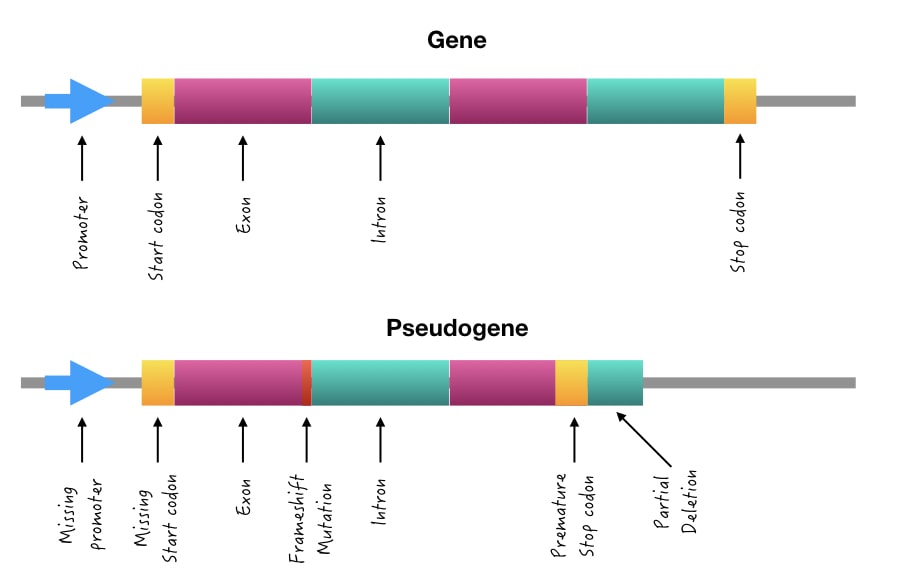“Learn about types of pseudogenes- processed, non-processed and unitary pseudogenes and various mechanisms involved in their formation. Explore the role of gene duplication and retrotransposition in pseudogene formation in this article.”
Pseudogenes are inactive copies of the homologous genes. They are functionally repressed by various events including insertion of mutations, like- frameshift, missense or nonsense mutation, loss of regulatory element or promoter and suppression by random indels.
It looks unintentional and random to conceive or lose protein-coding capacity by a gene and pseudogene, respectively but it’s certainly intentional. Evolution forces genes to become inactive either because the gene or encoded protein is no longer required or to regulate the expression of a gene.
Thus, unintentionally the so-called non-functional pseudogenes execute important functions for our genome. Regulating the overall genome functionality. Events that lead to the formation of pseudogenes are programmed for the formation of genes but by chance or intentionally, they convert into pseudogenes.
Two such events are gene duplication and retrotransposition which can form unprocessed and processed pseudogenes, makes genes inactive and provides additional genomic diversity. In our previous article (Pseudogene 101), we discussed what pseudogenes are and how they differ from genes.
In this article, I will explain to you two common types of pseudogenes– processed and unprocessed pseudogenes and also, unitary pseudogenes and their importance in our genome. I will also explain how gene duplication and retrotransposition occur in the context of pseudogenes.
Stay tuned.

Key Topics:
Processed pseudogenes and retrotransposition:
As I mentioned in our previous article, processed pseudogenes, simply means, are formed by/during the processing of a gene. They are distinct from other classes of pseudogenes having the capacity to transcribe into mRNA. However, they become ‘dead on arrival.’
Retrotransposition is a kind of transposition that, using the mRNA, transfers the gene from one to another location in the genome, by reverse transcription. Such transcript lacks the 5’ upstream promoter region & introns, possesses poly-A tail and small flanking direct repeats.
Using enzyme reverse transcription, the altered double-stranded mRNA forms single-stranded cDNA becomes double-stranded and is re-inserted into the genome. A major portion of our genome is made up of retrotransposons.
The re-insertion might be either adjacent to the homologous genes, on the same chromosome or a different chromosome. The entire mechanism is guided by the non-LTR retrotransposon LINEs machinery for reverse transcription.
Such processed pseudogenes are often known as retropseudogenes or ‘genomic fossils’ as they are present in our genome even before the divergence of human and mouse genomes. Recent data suggest that there are ~8780 processed pseudogenes the human genome possesses. Chromosome 22 contains the highest number of processed pseudogenes.
Over ⅓ of the human genome carries retrotransposons which makes the genome highly unstable and thereby provides diversity.
Related article: Transposons in eukaryotes.
Unprocessed pseudogenes and gene duplication:
Unprocessed pseudogenes don’t process by retrotransposition, instead, it is formed by the abruption in the normal gene duplication (replication process). Gene duplication is, simply, the process of copying any gene or even DNA sequences. Which is popularly known as replication.
Replication is an enzyme-governed catalytic reaction in which any gene or DNA gets replicated, doubled and transmitted to daughter cells. During the replication, when crossing over occurs between two homologous chromosomes, unprocessed pseudogenes are formed.
Indeed, it’s such a type of pseudogenes that is produced by two events, duplication or replication and acquisition of subsequent mutations. Replication exactly copies the native gene which almost has intact promoters, exons and introns but the occurrence of mutations like premature start or stop codon, silent, missense or frameshift mutation leads to inactivation and formation of duplicated pseudogenes.
300 various duplicated or non-processed pseudogenes are present in the human genome.

Unitary pseudogenes:
Natural mutagenesis is a random and common process that occurs in a cell, however, majorities of mutations are repaired by cells’ DNA repair mechanism which eventually restores or holds the natural function of any gene. Some genes get mutations whose function isn’t important or no longer required for the cells; such genes become repressed by negative natural selection.
Unitary pseudogenes simply mean pseudogenes that were active genes in our ancestors but are now inactive or non-function by any means including natural mutagenesis. A cell tries to repair an unnecessary mutation but sometimes fails to do the job and in addition, the cell no longer requires that gene as well.
So overall, the re-activation or in-activation doesn’t have any significance. Such pseudogenes are unitary pseudogenes. As over time, organisms evolve, plenty of unitary pseudogenes are formed.
This is the reason, unitary pseudogenes are also known as ‘genetic relics of genes’ or ‘Vestigial DNA sequences.’ Importantly, these pseudogenes provide important information regarding the process of evolution and hence are important to study.
Wrapping up:
In conclusion, Processed pseudogenes are formed by the process of retrotransposition while unprocessed pseudogenes which are often known as duplicated pseudogenes are formed by the process of gene duplication (homologous recombination).
Pseudogenes are though classed into the non-coding but do have significant importance in various processes like post-translational modifications, gene regulation, etc. So this is it for pseudogenes 102. If you want to learn more, you can read our previous article on this series.
I hope you like this article. Do share it and bookmark the page.


